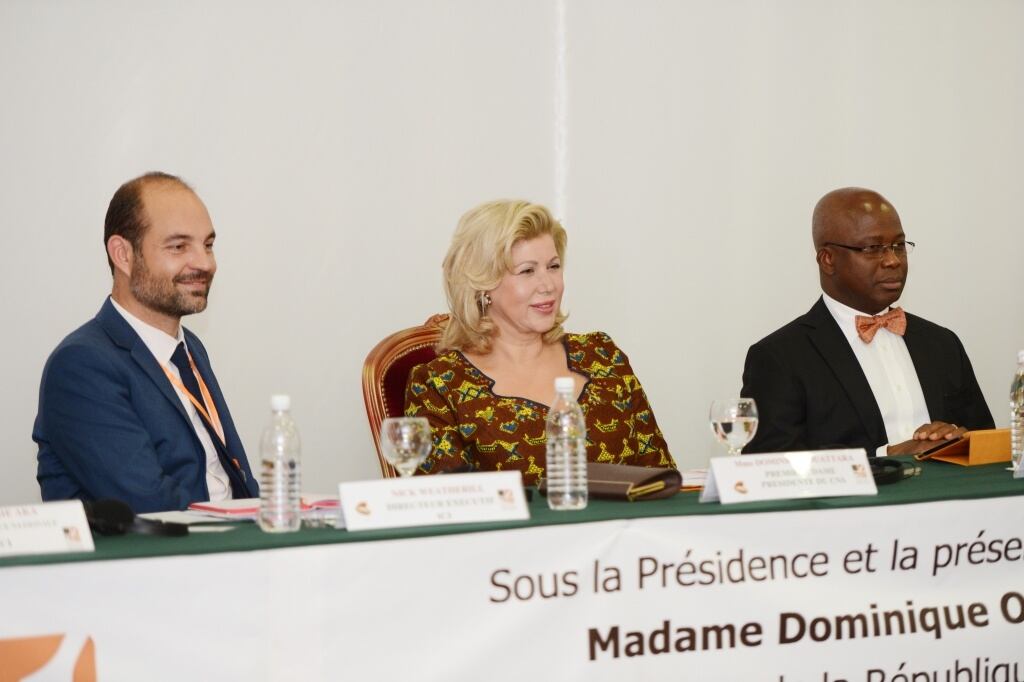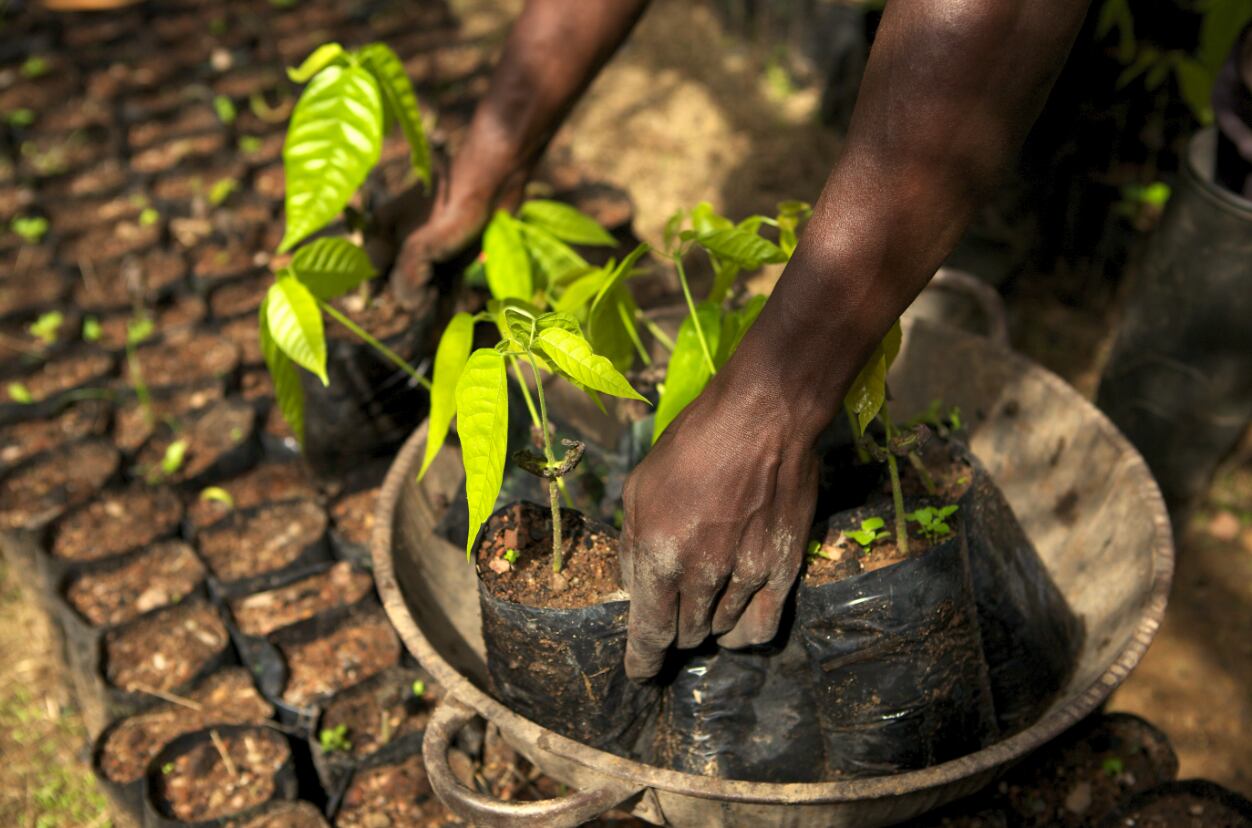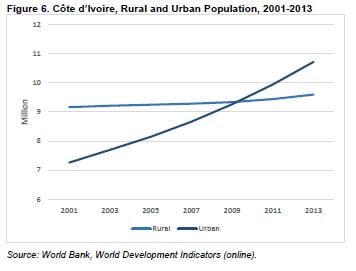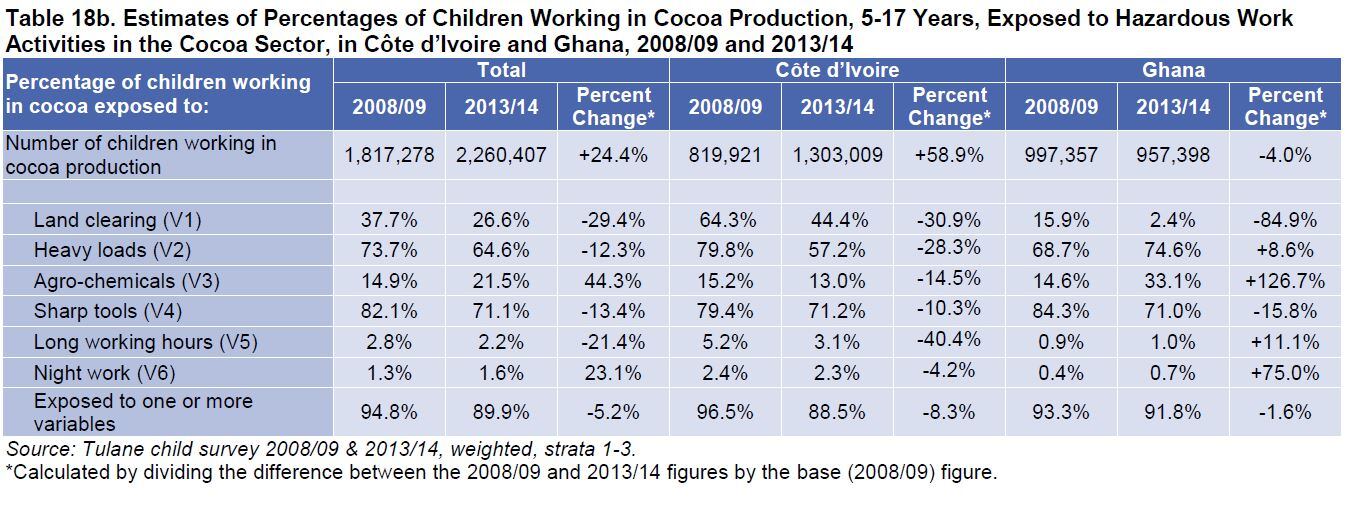Tulane University today published its ‘Survey Research on Child Labor in West African Cocoa Growing Areas’, which was financed by the U.S. Department of Labor.
The research found 2.26m children were working in cocoa production in Côte d’Ivoire and Ghana during the 2013/14 harvest season, up 21% from 2008/09.
Of those children in 2013/14, 2.03m were working in hazardous work, up 18% from 2008/09. That means almost every third child living in an agricultural household in the two countries is engaged in hazardous work to produce cocoa, for which the chocolate industry and retailers are the ultimate beneficiaries.
‘Shift up a gear’
What is hazardous work?

Tulane University used 'hazardous work' as a proxy for the worst forms of child labor Hazardous work includes: land clearing, carrying heavy loads, exposure to agro-chemicals, using sharp tools, long working hours and night work.
“This is a rallying call for everyone to do more to do it better and to do it together,” said Nick Weatherill, executive director, International Cocoa Initiative (ICI), an organization whose members include Mars, Mondelēz, Hershey and Nestlé, “We know that our community child protection model has significant impact, but needs to be scaled up to reach more communities, and it also needs to be matched with supportive government policies and actions in both countries.”
He said: “Hundreds of thousands of children are still at risk and we need to shift up a gear.”
Bill Guyton, president of the World Cocoa Foundation told ConfectioneryNews by phone: “We are disappointed there has not been more progress made, but we are not discouraged.”
He said combating child labor was a shared responsibility with producing governments and said the industry was better aligned with governments and working more closely with NGOs than ever before. "Raising awareness was the first step; adopting changes at the farm level is now the challenge and our main focus," he said.
Broken promises or complex issue?

The biggest players in the $80bn chocolate industry pledged “to eliminate the worst forms of child labor in the cocoa sectors of Ghana and Côte d’Ivoire” in the 2001 Harkin-Engel protocol. The largest brands and processors said by July 1 2005 there would be voluntary industry-wide standards of public certification to ensure cocoa beans were grown without the worst forms of child labor.
In 2010, it was acknowledged the Harkin-Engel Protocol hadn’t gone to plan and the international chocolate industry signed a new declaration on the Harkin-Engel Protocol along with Ministers from Côte d'Ivoire and Ghana. The industry pledged instead to reduce the world forms of child labor in the two countries by 70% by 2020.
“Without a continuing commitment of financial and other resources by all stakeholders, the 2020 target is highly unlikely to be reached,” said Tulane’s report. Around 2.1m children need to be removed from hazardous cocoa work to reach the 2020 target.
Mondelēz 'concerned'

The world’s largest chocolate company told ConfectioneryNews it was “concerned” by the reported increase in cocoa child labor. It says its $400m, 10-year Cocoa Life program launched in 2012 helps to address the root causes of child labor with training from NGO partners and by promoting education and improving farmer livelihoods. “Ultimately we aim to source all of our cocoa sustainably, mainly via Cocoa Life,” said the firm. Cocoa Life currently accounts for around 10% of the firm’s cocoa supply and it has set no deadline to move to 100%. Mondelēz says it has appointed human rights consultancy Embode to identify measures to tackle child labor.
WCF’s Bill Guyton said: “It’s a lofty goal. It’s important to keep that…whether we meet it or not, we’ll see….In 2001 and 2010 we didn’t have platforms like CocoaAction and alignment with the governments of Côte d’Ivoire and Ghana.”
CocoaAction plans to help professionalize 300,000 cocoa farmers in West Africa. “As you begin to see farmers more professionalized, they will have the opportunity to hire labor,” said Guyton.
Possible explanations: Production increase and population rise
The Tulane study said rising cocoa production in both countries - a 40% rise in Côte d’Ivoire and over 30% in Ghana between the years of data collection – partly explained the increase in child laborers.
The largest global cocoa grower Côte D’Ivoire also suffered from the effects of post-election violence in 2010-11 and is still rebuilding its education infrastructure, said the report.
Population growth and migration may have also contributed to the rise, said Tulane. For example, the population increased 3.4% in Ghana and 2.8% in Côte d’Ivoire between 2009 and 2013, according to World Bank data.
Injuries and chemical exposure
Tulane found a 29% reduction in children participating in hazardous land clearing in both countries, but exposure to agro-chemicals rose 44%.

Many children reported suffering wound and cuts, insect bites, muscle pains and skin itchiness from their work, the survey found.
This came despite improved access to education over the review period with 71% of cocoa child laborers attending school in Côte D’Ivoire in 2013/14 compared to 59% in 2008/09.
According to ILO standards, no child below the age of 12 should engage in work. Tulane found just under a quarter of the 2.03m children in hazardous cocoa work were between 5 and 11 years old.

Money talks
Tulane said calls for child labor free chocolate would become louder, particularly as global demand for cocoa grows. It called on the industry to make major investments to tackle the issue.
WCF, whose members include Ferrero, Mars and Hershey, said collective efforts by the chocolate industry and governments “have not been sufficient”. It said it was investing more than $500 million in cocoa sustainability in the next few years through joint efforts such as CocoaAction. But is that a drop in the ocean for the global chocolate confectionery that records over $80bn in value sales a year?
“It’s not just about the money that’s going into the projects –at the end of the day we’ll be judged on impact on the ground,” said Guyton.
U.S. government reacts: ‘A wake up call’

The U.S. Department of Labor associate deputy undersecretary for international affairs Eric Biel praised the chocolate industry’s commitment to the issue, but added: “Tulane’s report serves as a wake-up call. None of us can tackle this issue on our own. What is needed is a renewed commitment from all parties.” The department recently announced $12 million in new funding for three projects to combat child labor in West African cocoa-growing regions.
